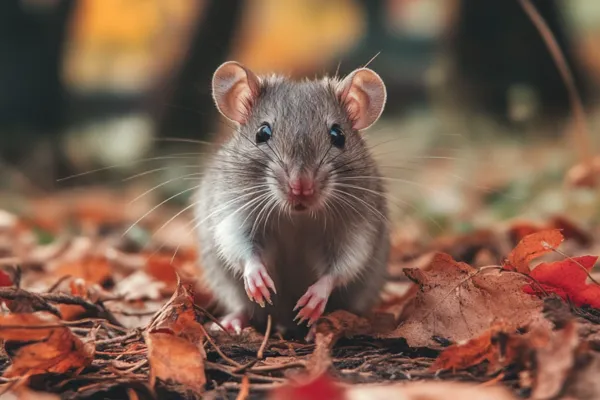
The Telford Pest Control Journal
Educational insights into how to keep your Telford home or business pest free

Autumn Invaders: Preparing Your Much Wenlock Home for Seasonal Pests
Why Seasonal Pests Increase During Autumn
As temperatures drop, many pests that thrive outdoors during the warmer months look for warmer environments. Your home offers shelter, food, and warmth—an irresistible combination for pests trying to survive the colder weather. Rodents can chew through insulation and wiring, spiders tend to find hiding spots in corners, and moisture-loving woodlice thrive in damp areas like basements or kitchens. Preparing your home with preventative measures now can save you from dealing with full-blown infestations later.
Key Steps to Prevent Autumn Pests
Seal Entry Points
Rodents, spiders, and woodlice can find their way inside through even the smallest gaps and cracks in your home’s exterior.
Inspect windows, doors, and foundations for cracks or gaps, especially around utility pipes.
Seal cracks and gaps with caulking or weather stripping.
Install door sweeps on exterior doors to block rodents and insects from squeezing in.
Declutter and Clean Your Home
Pests are attracted to clutter and mess as they offer hiding spots and sometimes food sources.
Keep your home tidy by vacuuming regularly, especially in corners and under furniture where spiders may spin webs.
Store food in airtight containers to prevent attracting rodents or insects.
Remove clutter from basements, lofts, and garages, where pests are more likely to hide undisturbed.
Eliminate Moisture Sources
Woodlice thrive in damp environments, making moisture control essential during the cooler months.
Fix any leaky pipes, taps, or appliances to reduce excess moisture inside your home.
Use dehumidifiers in damp areas such as basements or laundry rooms to make the environment less hospitable for woodlice.
Ensure gutters and downspouts are clear of debris, as blocked gutters can lead to water accumulation near your home’s foundation.
Inspect and Maintain Outdoor Areas
Your garden can be a hotspot for attracting pests like rodents and spiders, which may then make their way indoors.
Trim back trees and shrubs that touch your home to reduce pathways for pests.
Store firewood and garden waste away from your home’s foundation to avoid providing shelter for rodents and insects.
Ensure rubbish bins have tight-fitting lids and keep them away from your home to reduce rodent attraction.
Regular Pest Inspections
One of the best ways to keep pests at bay is through regular inspections by pest control professionals.
Schedule a seasonal inspection with Maximum Pest Control to identify potential pest entry points and address any early signs of infestation.
A professional can also apply preventative treatments around your home to keep pests out before they become a problem.
Common Signs of a Pest Infestation
Recognising the early signs of a pest infestation is essential for preventing small issues from becoming major problems. By knowing what to look for, homeowners can take quick action to address infestations before they cause serious damage or health risks. Here are some key indicators that you may have a pest problem in your Much Wenlock home:
Rodents
Rodents such as mice and rats can quickly make themselves at home, often going unnoticed until the infestation becomes significant. Common signs include:
Droppings: Small, dark droppings, typically found in kitchen cupboards, pantries, or along skirting boards.
Gnaw Marks: Rodents constantly gnaw to keep their teeth from overgrowing. Look for chew marks on wooden furniture, wires, or food packaging.
Scratching Sounds: If you hear scratching noises in the walls, ceiling, or loft, especially at night, it may indicate the presence of rodents.
Nesting Materials: Rodents often use shredded paper, fabric, or insulation to build nests in hidden areas such as lofts, basements, or behind appliances.
Spiders
While many spiders are harmless, their presence can be unsettling, especially in large numbers. Here are some signs that spiders may be residing in your home:
Webs: The most obvious sign is the presence of spider webs. Check for webs in the corners of rooms, basements, lofts, and other undisturbed areas.
Egg Sacs: These small, round sacs may appear in webs or hidden in corners, indicating that spiders are reproducing in your home.
Spider Sightings: Spotting spiders regularly, especially indoors, can indicate an infestation. Spiders are often drawn to dark, secluded spaces.
Woodlice
Woodlice are moisture-loving pests that indicate dampness in your home, and while they don’t cause direct harm, their presence signals a moisture issue that can lead to more serious problems.
Visible Woodlice: Spotting woodlice around damp areas such as bathrooms, kitchens, or basements is a key sign of infestation. They are typically found in groups, especially near sinks, baths, or leaking pipes.
Damp or Rotting Wood: Woodlice thrive in moist conditions, so their presence often points to water damage, rotting wood, or high humidity levels in your home.
Pest-Proofing for Pet Owners
If you’re a pet owner, pest-proofing your home requires extra care to ensure that your furry friends stay safe while keeping pests at bay. Here are some effective ways to pest-proof your home that prioritise both your pet’s safety and the health of your household.
Pet-Safe Traps: Traditional pest traps can pose a risk to pets, especially if they are curious about new objects in their environment. Fortunately, there are safer alternatives:
Enclosed Traps: Opt for enclosed traps that allow rodents to enter but prevent your pets from accessing the inside. These traps are ideal for homes with dogs or cats who might investigate open traps.
Electronic Traps: Another safe option is electronic traps, which deliver a quick, humane kill to rodents without using harmful chemicals. These are pet-friendly as long as they’re placed in areas that your pets cannot reach.
Non-Toxic Baits: If using baits, choose non-toxic, pet-safe bait products. Always place bait traps in areas inaccessible to your pets, such as lofts, behind furniture, or under appliances.
Flea and Tick Prevention: Fleas and ticks are not only a nuisance for pets but can also infest your home, leading to itching, discomfort, and even health issues for your pets and family.
Regular Flea Treatments: Apply vet-approved flea treatments to your pets regularly, especially during the cooler months when fleas may seek warmth indoors. Flea collars, topical treatments, and oral medications are all effective options.
Inspect After Outdoor Time: Check your pets for ticks after they’ve been outdoors, especially in wooded or grassy areas. Remove any ticks immediately with a tick remover tool or tweezers.
Maintain a Clean Environment: Vacuum frequently and wash your pet’s bedding in hot water to eliminate flea eggs and larvae. Keeping your home clean and free of excess pet fur or dander will also reduce the likelihood of infestations.
Professional Flea Control: If your pet shows signs of a flea infestation, such as excessive scratching or biting, it’s essential to act quickly. In addition to treating your pet, consider a professional pest control service to address fleas within your home.
Why Proactive Pest Control is Essential in Autumn
Preventive pest control is crucial during autumn, as it stops potential problems before they escalate. By sealing entry points, eliminating moisture sources, and staying vigilant, you can greatly reduce the likelihood of pests invading your home. Pest infestations not only cause discomfort but can also result in damage to your property, especially in the case of rodents, which may gnaw on wiring and create fire hazards.
Maximum Pest Control offers comprehensive home protection plans designed to keep your home pest-free during autumn and throughout the year. Our team of experienced professionals will inspect your home, apply preventative treatments, and provide recommendations to ensure you remain pest-free as the temperatures drop.
For more information or to schedule an inspection, visit Telford Exterminator's Website or call us at 07835 934351 / 01952 728323.

Schedule a Pest Inspection
Ready to schedule a pest inspection? Contact us today.

Schedule a Solar Panel Proofing
We also offer Solar Panel Bird Proofing in the Telford area.
